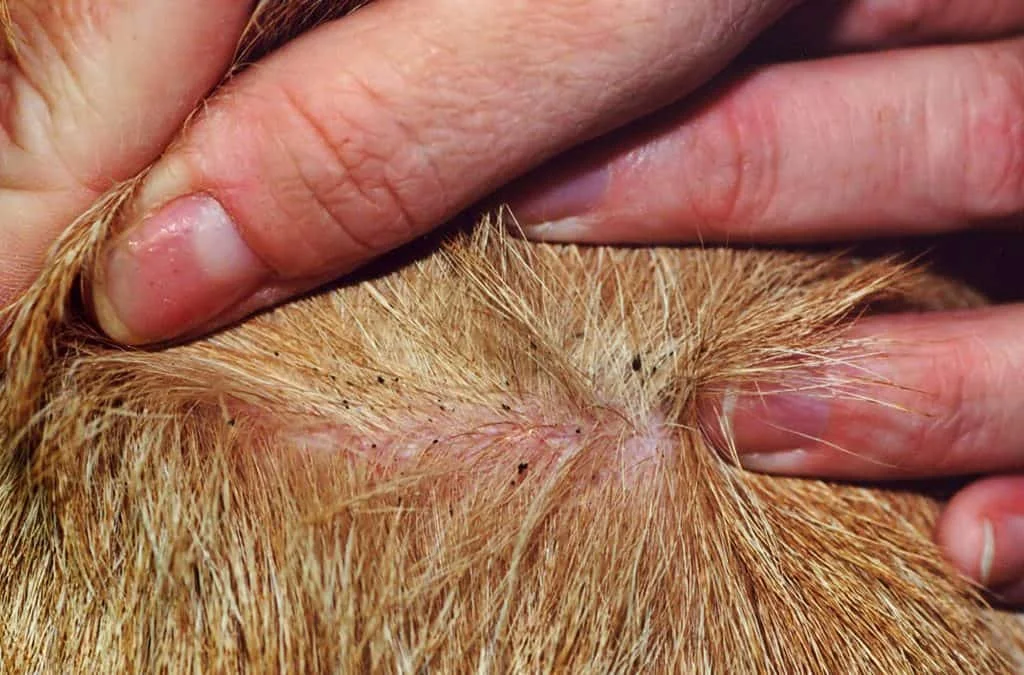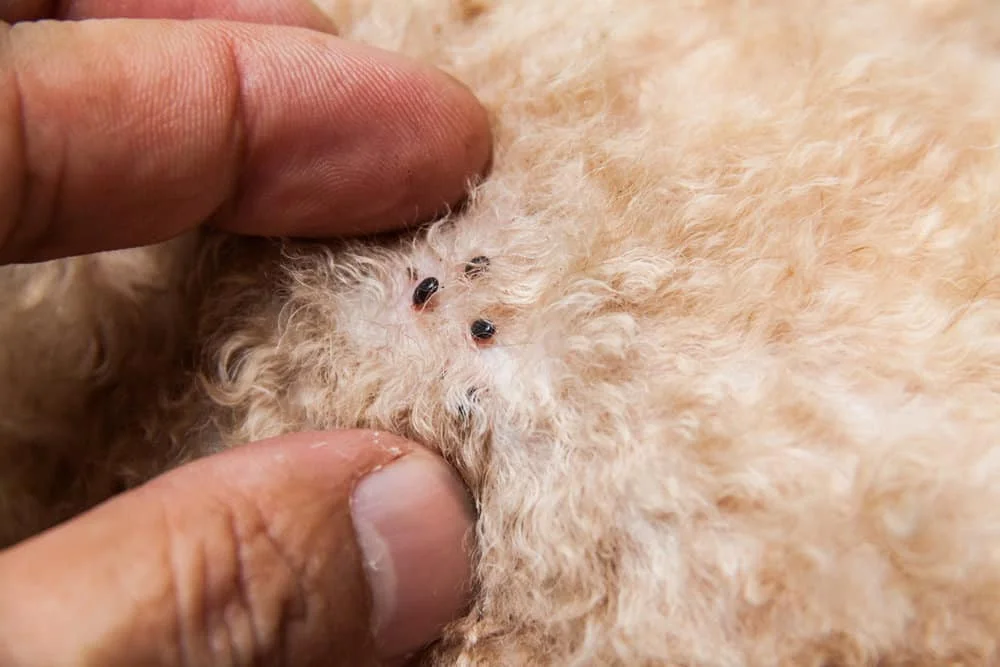Fleas are a dog parent’s worst nightmare – and even more so if you own a Goldendoodle. With your dog’s thick and curly coat, fleas can spread very quickly and can be difficult to remove. Doodles are high-energy dogs and love to be outdoors, which is exactly where they get fleas or ticks.
As a general rule, to keep your Goldendoodle free of fleas, it is important to catch early signs of the problem. You can then move to early treatments like flea removal tools and targeted medications. You must also take steps to prevent a re-infestation by securing both your dog and your home against fleas and ticks.
Goldendoodle coat maintenance can be difficult. However, catching a flea problem early on can greatly help you get rid of it quickly and effectively.

How Can You Tell If Your Dog Has Fleas or Ticks?
Fleas and ticks are small and quick. This coupled with your dog’s curly coat means that you might never spot them unless you are specifically checking for them. It is important to under the signs and symptoms of fleas to catch them early on because they spread terribly fast.
They can also jump onto your furniture, carpets, and drapes, which is all the more reason to find them as quickly as possible.
The following 10 signs indicate that your Goldendoodle has fleas and/or ticks.
- Black dirt-like flea droppings on your pet’s coat or the floor/carpet surrounding them.
- Tiny white grains in your dog’s fur. These are flea eggs.
- Excessive scratching, licking, or biting the skin.
- Redness and/or inflammation.
- Bumpy skin.
- Irritated skin around the neck or belly.
- Sudden and inexplicable shedding.
- Dry brown or black spots on the skin.
- Scabs.
- Tapeworms.
How to Check Your Dog for Fleas and Ticks
If you think your dog is showing signs of an infestation, you can carry out a physical exam yourself. Part your dog’s fur with your fingers until the skin is exposed. You will likely see bumpy skin or red, brown, or black spots. You might also see tiny fleas that quickly disappear into the fur.
Ticks are much larger than fleas and easier to spot and usually stay in one spot. Make sure you check inside and behind your dog’s ears as well as in the folds of the neck since this is where these parasites are most likely to be found.
Here is a great reference video from AKC.com

How to Remove Fleas and Ticks
If you catch the fleas really early on, you may be able to use a flea comb to get rid of them. If you decide to do this, make sure you use gloves and have a bowl of water nearby. As you comb out the fleas, drop them in water, and flush them down the toilet when you are done.
However, it is usually difficult to get rid of a serious infestation just with a comb.
For Fleas:
Consult your vet for topical or oral treatments. You should be able to find flea shampoos and sprays meant specifically for dogs. Usually, you need to give your dog a bath with flea and tick shampoo. Once the coat dries, completely soak it in the given spray and let it sit in as directed.
You can then rinse your dog again and the fleas should fall right out. Using a comb after the second rinse will get rid of any remaining fleas. However, keep in mind that instructions vary from product to product.
You will also need to thoroughly clean your house including all the rugs, beds, and any other things that the dog usually comes in contact with. Thoroughly wash these with a strong anti-insect or flea-specific product.
You can find the Top Selling Flea Sprays here on Amazon
For Ticks:
Tick removal can be slightly more complicated since these insects have their legs embedded into the pet’s skin. Using gloves, you need to use a pair of tweezers to grasp the tick as close as possible to your dog’s skin and pull straight up in a steady motion.
If you have not done this before, it is best to leave this up to a professional. This is because the ticks need to come out whole; if any part of them stays embedded in your dog’s skin, this could lead to tick fever or even Lyme Disease.
Your vet may also recommend specific sprays and shampoos that will loosen the ticks, making it easier to remove them after a bath. You may get oral medication to prevent flea and tick-related infections.
You can find the Top Selling Tick Sprays here on Amazon

What Months Are Fleas and Ticks Most Active?
Depending on where you live and what the climate is, there may be specific months and weather conditions when you should be most vigilant about your dog catching fleas and ticks. For most places with varied temperatures and seasons, flea/tick season is usually spring-summer, between May and September.
For warmer areas that experience mild-warm temperature at all times, fleas may breed year-round. Extreme hot and cold temperatures are both free of fleas and ticks since the weather usually destroys these insects and their eggs.
If you live in an area where fleas are most likely to be found in the summer, take the following steps:
- Monitor your dog’s walks. Avoid overgrown vegetation and keep your dog from venturing into bushes.
- If you have a yard, you should make it a habit to adequately maintain it and annually treat it with flea-prevention products before the flea season hits.
- Use a natural and dog-safe remedy like peppermint or rosemary essential oils to prevent your dog from catching fleas on walks. These should be diluted with water to make a spray.
How to Prevent Fleas and Ticks in Your Dog
The last thing you want as a pet owner is a re-infestation of fleas. Moving forward, it is important to take the right steps to keep your dog and your home free of fleas.
- Use a flea comb on your pet every time you give them a bath.
- Wash your Doodle’s bedding at least once a week.
- If you face the problem regularly, look into a flea/tick collar, especially for walks.
- Ensure a clean lawn by regularly mowing, raking dead leaves, and removing tall weeds.
- Invest in a good quality flea and tick spray and use this around your home during flea season.
Fleas and ticks can be frightening and can certainly bother your Goldendoodle a lot. However, catching them early is the key. To make sure you prevent this from happening altogether, keep your home clean and disinfected, and regularly groom and trim your dog’s fur.
